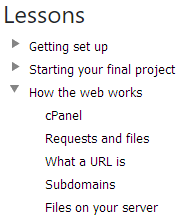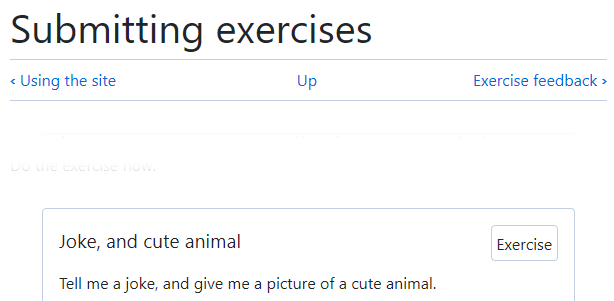This course was built to match the way that people learn skills. You can read about the research behind the design, on the Skilling website.
Use the site the way it's designed, you'll learn effectively, and efficiently. Take shortcuts, and you might make things harder for yourself.
The problem is that strategies that seem efficient, actually aren't.
Working backwards
Like working backwards through lessons. Most lessons have an exercise at the end. So, jump to the end of the lesson, read the exercise, and scan the page backwards, to find what you need to do the exercise. Efficient, right?
That's good in many situations, just not for this course. Lessons are designed to be read from top to bottom. They introduce a concept, then add a little complexity, then a little more. This limits your cognitive load, that is, how many things you need to think about at one time. It makes learning efficient.
When you work backwards, you hit the most complex stuff first. You might be able to cut-and-paste and get code working, but you won't understand why it works. You'll have trouble with exercises that build on what you didn't learn properly.
So...
Work on lessons from top to bottom
Don't skip to the bottom, find the exercise, and work back to the top. Start at the top, and work down.
This is the most important piece of advice on this page.
Don't skip the More buttons
The More buttons break lessons into chunks. That's called "segmenting" in learning research. It reduces cognitive load.
Now, the More buttons have an arrow, with a "Show all" option.

Click it, the More buttons vanish, and you can see the entire.
Don't use "Show all" the first time you read a lesson. "Show all" is there for when you've already read a lesson, and are coming back to find something to review, or code to cut-and-paste. In that case, the More buttons get in the way of your scanning the page to find what you want.
But, the first time you read a lesson, use the More buttons, one at a time. It's easier on your brain.
Work through the lesson tree
The lesson tree is your table of contents for the course.

Start at the top, and keep going until you get to the end.
Do exercises when you find them in lessons
You can get to exercises in at least four ways.
- Exercises are embedded in lessons. For example, the Submitting exercises lesson has an exercise at the bottom:

- The exercise timeline

- Your submissions list
- List | Exercises
Use the first one. That is, do exercises as you come across them, when you're reading the lessons.

Adela
What are the other methods for?
They're for convenience when you're looking for feedback, checking your progress, or finding an exercise you did, so you can copy some of its code. However, when you want to work on new material, go to the lessons list, not the timeline.
Answer the embedded questions
You'll some across questions, like this:

Answer them.
The questions are not there to test you. Instead, they're there to remind you of things that relate to the lesson you're about the read. That's called "activating prior knowledge" in learning research. It helps you learn more efficiently, by tying what you're about the read, to what you already know.
Don't skip things you don't understand
When you don't understand something you read, it's easy to give up, and skip it. That will cause problems later on. Instead:
- Read it again more slowly, thinking about each step. Even if it hurts, and strains your self-confidence.
- Try the code samples in the lesson. Use the debugger.
- Ask friends to explain it to you. <- This is a good one.
- Ask your instructor.
- Ask the interwebs.
The last one is a bit tricky. This course covers only the basics of VBA. You'll find a lot of answers on the 'net using concepts you haven't learned. You might have to try other websites, in that case.
Suggestions
There's a Suggestion button (when you're logged in). If you think an explanation is confusing, please suggest that it be improved. That will really help!
The person who made this site is an expert. In learning research, there's something called the "expert's blind spot." Experts know a topic so well, they've forgotten what it's like to learn that topic. Things that are problems for students won't even occur to them.
If an explanation confuses you, most likely there's a problem with the explanation. And other people are probably confused, too. So, please suggest away!
